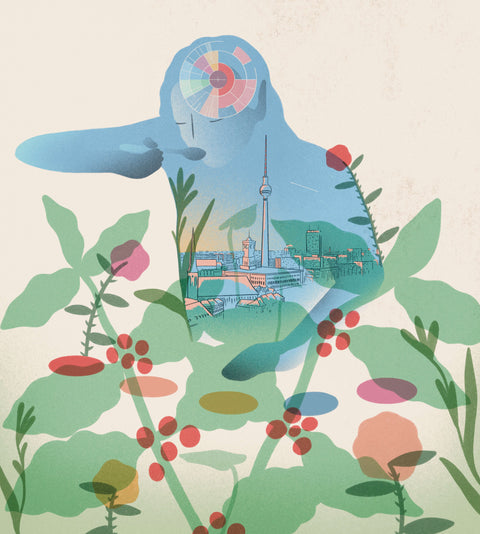Join us for a conversation with Ian Fretheim, Director of Sensory Analysis at Cafe Imports, a proud partner of Standart Issue 32.
Would you tell us about your new cupping tool, The Coffee Rose? And where does its name come from?
The Coffee Rose is an interactive flavour wheel that we use to directly describe and assess coffees while cupping. Each descriptor on the flavour wheel is a button, and the tiers are organized such that a user can select simple descriptors (fruit) or create more complex descriptors (fruit – dried – berry – blueberry). Selections are entered into the system by indicating the intensity of the experience on a scale that ranges from “baseline specialty” to “as intense as you’d expect to encounter”.
Each button also has a value associated with it, and those values differ based on specificity (fruit vs blueberry) and content (raspberry vs cranberry). Intensity indications also have values associated with them. Both positive and negative descriptors exist on the flavour wheel. The greater the impact on sensory experience the greater the impact on score.
Descriptions and values are based on the degree to which any given attribute differs from what you would expect to find in a “flat 80” just specialty quality coffee.
More technically: the Coffee Rose combines Rich Content, Dynamic CATA (check-all-that-apply) and RATA (rate-all-that-apply) methodologies to solve problems with both legacy cupping and CATA assessment forms. The Coffee Rose offers the ease of use of CATA and RATA while significantly expanding the descriptive capabilities of those methods and avoiding the unwieldy array proliferation that would normally occur in a legacy list-based interface. Vs legacy cupping forms, the Coffee Rose places its focus on coffee attributes rather than cuppers and allows cuppers to work in a single, descriptive or experience-translative mode as opposed to constantly needing to switch from numbers, to language, to identification, to counting and of course then to math.
As a novel solution, the Coffee Rose is a Synthesis of sensory Analysis and coffee Experience.
The name was derived from the output of the sunburst chart, which displays just the items that were selected for a coffee and resembles a flower or rose.

What was the idea behind The Coffee Rose and were there specific challenges or gaps in existing cupping tools that you wanted to address in its development?
I had been making good progress working on a new scoring model (the algorithm that allows us to separate scoring or valuation of coffee attributes from assessment or measurement of coffee attributes) back in 2019. At that time, I was still conceiving of a numeric and tick-mark-based user interface (built around improving our QDA (quantitative descriptive analysis) cupping form) when it occurred to me that this new model (or scoring engine) allowed us to depart radically from the more linear, intimidating, and conceptually taxing user interfaces that we’re accustomed to seeing in specialty coffee.
Years earlier I had designed a sort of coffee-tasting matrix for a customer to be used for training purposes. The matrix arrayed and related coffee flavours, profile types, and roast expressions and while we used it in several different ways, essentially asked users to place or map coffees to it based on what they thought were the most important and descriptive components. It was sort of an organoleptic least squares point plotting approach.
One morning it occurred to me that if I could plug the scoring engine into something like the tasting matrix, then I could create an interactive, visual, and completely descriptive interface that would jettison many of the flaws inherent in both legacy and proposed cupping methodologies.
I don’t see the Coffee Rose replacing legacy or proposed cupping score sheets. Our business is buying and selling coffee, not memberships and classes. We’re making an initial version available this spring, and if people are engaged with using it and finding that it makes coffee description, communication, education, and training easier, then I think that’s wonderful. We’ll look to follow that version up with a fuller feature version like the one that we use for sample workflow organization and analysis if people are interested in that.
Numerous gaps in legacy cupping tools lead us to this point. We were off of the legacy tools at Cafe Imports before I started here in 2011. In 2017 or so I designed and transitioned us to a QDA-based cupping form. A few of the larger gaps include those forms being focused on cupper opinions, not coffee attributes; requiring cuppers to engage numerous cognitive modes; lacking definitions of quality despite claiming to be based on quality; promoting user-defined shortcuts; and being clunky to use.

How could The Coffee Rose enhance the cupping experience?
1) Paradigm: The underlying philosophy of the Coffee Rose is to free cuppers to focus completely on describing what they are tasting. No more math. No more backfilling attributes to achieve a target final score. No more Keynesian beauty-contest-style guessing as to what others will score. Cuppers describe coffees, with standard score descriptions.
2) Transparency: We need to talk about the cupping experience of the people whose coffee is being cupped. In legacy and proposed systems there are no definitions, statements, or standards of value. For all the time, ink, and money spent and solicited discussing quality discovery and now coffee value assessment, that quality and this value still boil down to literally undefined momentary impressions of user preference. Whether the cupper thinks the flavour “lemon” is high quality or distinct is up to the cupper. They must make that decision at every table and for every coffee, over and over, every day. Not only does this add a significant burden to the cupper, but it also renders the coffee supplier’s experience of cupping completely opaque. Whether “lemon” is good or bad cannot be known until after a cupping is over because the value is not tied to the descriptor and is not associated with the descriptor until the cupping is underway. That association is not finalized until the cupping is complete, and yet that same association is only valid for that specific coffee.
In distinction to this, The Coffee Rose’s values, whether they are agreed with or not, are stated in advance of any cupping, roasting, or sample tender. Lemon is always lemon. Orange is always orange. Orange is always worth more than lemon. I understand that it is purely our judgment that orange is better than lemon. It’s not that I think this is the “correct” or only answer. It is just that I believe that we can only enter into “correct” purchase agreements, contracts, and relationships predicated on coffee quality if we offer traceable and transparent definitions of what we think coffee quality is and is not.
3) Accessibility: We’ve found that it makes cupping far more accessible, at least for some people. People with varying neuro divergence have reported and remarked on feeling that cupping was finally made available to them. This is an amazing and frankly unanticipated outcome. It is also of course anecdotal as we have not had the opportunity to formally test these reported experiences.
4) Strength: By leveraging the accessibility of CATA methodology and a relative RATA intensity measurement, the Coffee Rose leans into modalities that humans are relatively good at (descriptive selection and comparison) while eschewing the pain points endemic to legacy and proposed forms.
5) Training: While training and calibration are still very helpful with the Coffee Rose, the barrier to entry is much lower than with the assumed expertise required to render undefined judgments about quality, distinction, balance, etc. We have found that the learning curve for using the Rose dovetails wonderfully with and significantly accelerates that for learning how to cup.
What did you learn during the development of the tool?
So much. Three big ones:
1) The handicaps that we unconsciously give some coffees when we know what they are or how they are processed are far greater than most imagine. Blinding and replication are crucial.
2) If a coffee valuation/scoring system can “get close” people seem to be much less concerned with it not “being theirs” than I originally thought. I think this is highly related to the ease with which the input user interface works. In other words, it seems like people find legacy and proposed cupping forms so cumbersome and non-reflective of how they taste and experience coffee that the Coffee Rose, even with the scoring engine not being user-defined, is preferable.
3) Score gets in the way of cupper assessment to an amazing degree. Description and communication are much more important than people think and many cuppers struggle to accept that landing on the same score in a legacy system does not tell us whether we are calibrated (tasting the same coffee) or not. It’s a tough one to internalize, and it’s a great ah-ha moment to have cupping discussions with people outside of our company where we see a pattern emerge where we’re getting different scores but consistently describing coffees with related language that we value differently. I was cupping with a partner who was noting green and black tea-like flavours when I was noting herbal flavours. Herbal is a bit negative for me, and these tea flavours were positive for this cupper. Our scores were coming in around 3 points difference and yet we were tasting and describing similar things. Taking the time to set aside the score in order to identify, taste, and talk about that pattern allowed us to gain a much greater understanding of one another and of these particular coffees. We were more calibrated than the scores suggested and the initial reaction when sharing those scores was along the lines of “Uh oh, here we go.”
The Coffee Rose from Cafe Imports on Vimeo.
This interview was published in collaboration with Cafe Imports.
For more information about The Coffee Rose, head to Cafe Imports's website to find out more. Here is also a great webinar recording about The Coffee Rose.



